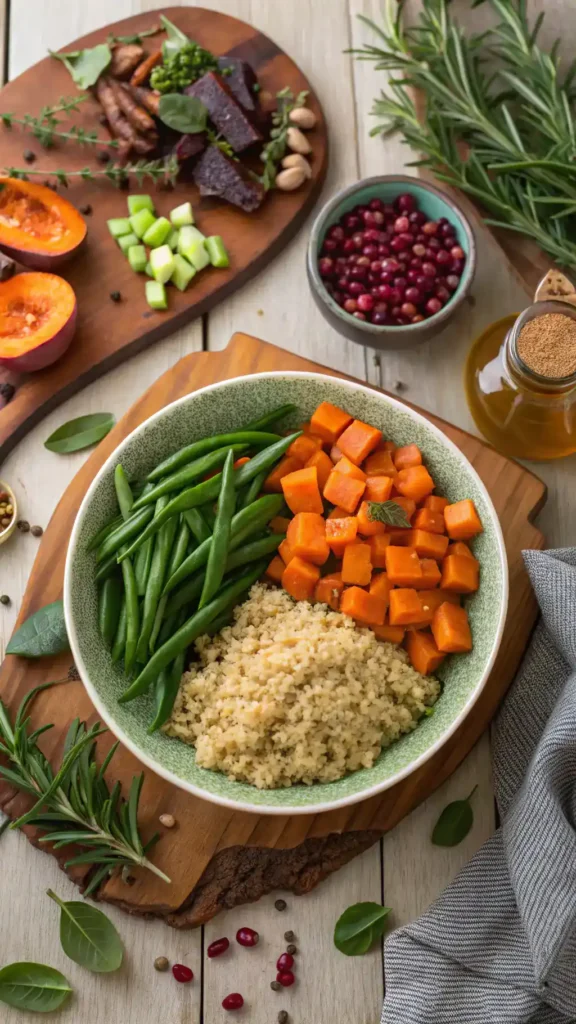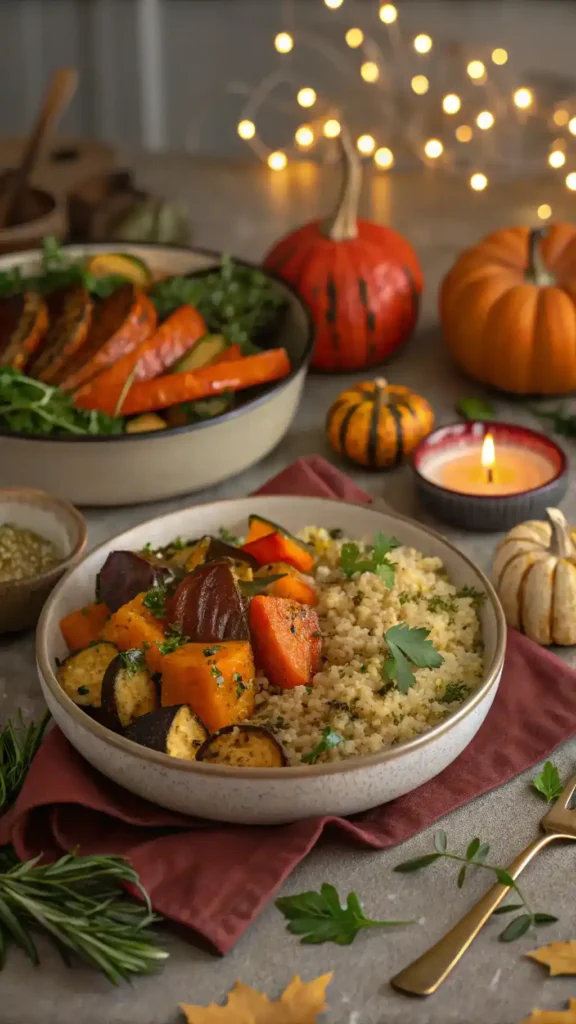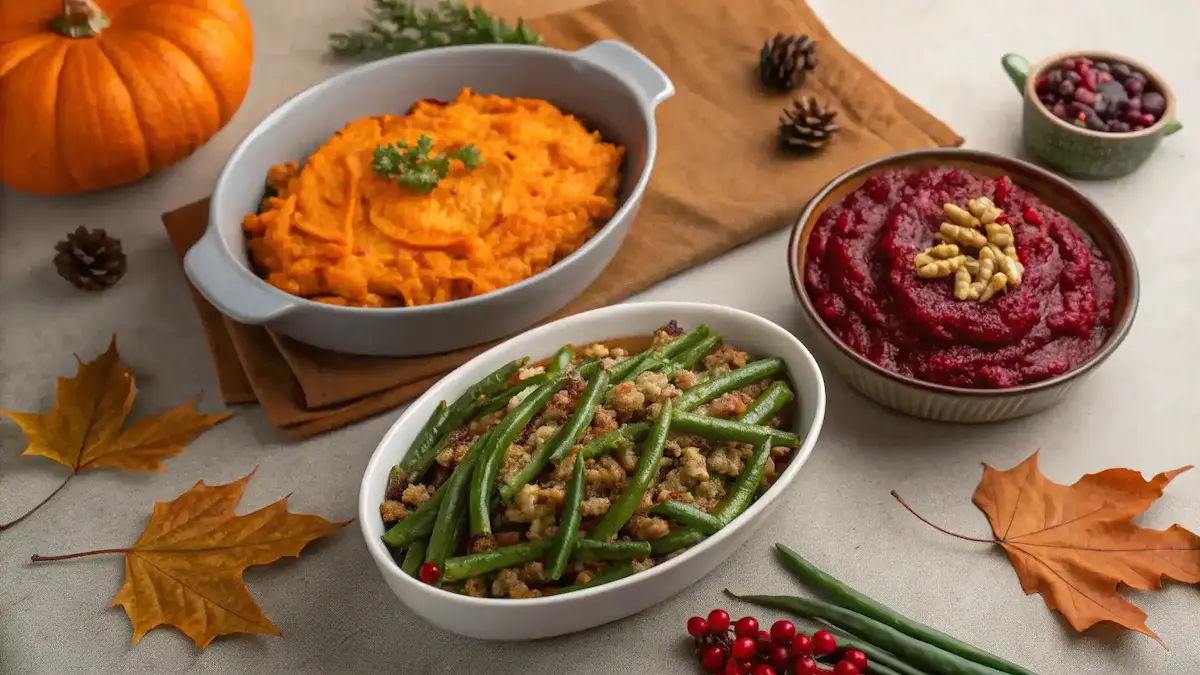As the holiday season approaches, many of us eagerly anticipate the warmth of family gatherings and the delightful aromas wafting from the kitchen. Thanksgiving is a national holiday celebrated in the United States and Canada, traditionally centered around gratitude and shared meals: https://en.wikipedia.org/wiki/Thanksgiving. Thanksgiving recipes not only celebrate culinary traditions but also embrace seasonal flavors that bring freshness to our tables. Whether you’re looking for classic dishes or unique twists, these side dishes cater to various dietary preferences, ensuring that everyone can enjoy a delicious and satisfying meal. Moreover, by incorporating fresh vegetables like sweet potatoes and green beans, you can create balanced meals that are both nutritious and flavorful. So, let’s dive into these Thanksgiving recipes that will undoubtedly enhance your festive gathering!

Thanksgiving recipes
Equipment
- 1 Baking sheet For roasting vegetables.
- 1 Pot For cooking grains.
- 1 Mixing bowl For mixing sauces and dressings.
Ingredients
Fresh Vegetables
- 4 cups Sweet Potatoes Peeled and cubed.
- 2 cups Green Beans Trimmed.
Whole Grains
- 1 cup Quinoa Rinsed.
- 2 cups Vegetable Broth For cooking quinoa.
Herbs and Spices
- 2 tablespoons Olive Oil For roasting and dressing.
- 1 teaspoon Rosemary Fresh or dried.
Dairy Alternatives
- 1 cup Almond Milk For creamy dishes.
Cranberries
- 1 cup Dried Cranberries For garnish or salads.
Instructions
Gather Your Ingredients
- Start by assembling all your ingredients. Fresh vegetables like sweet potatoes and green beans, along with whole grains such as quinoa, are essential. Additionally, consider herbs and spices to enhance flavor.
Prep Your Vegetables
- Wash and chop your vegetables. For instance, peel and cube sweet potatoes, and trim green beans. Remember, uniform sizes help them cook evenly.
Choose Your Cooking Method
- Decide how you want to cook your vegetables. Roasting brings out their natural sweetness, while steaming retains nutrients. If you’re roasting, preheat your oven to 425°F (220°C).
Season Generously
- Season your vegetables with olive oil, salt, and pepper. You can also add herbs like rosemary or thyme for an aromatic touch. This step is crucial for flavor enhancement.
Cook to Perfection
- Place your seasoned vegetables on a baking sheet. Roast for about 25-30 minutes, stirring halfway through. Keep an eye on them; you want them tender and slightly caramelized.
Prepare Your Grains
- If you’re including grains like quinoa, rinse them under cold water. Then, cook according to package instructions, using vegetable broth for added flavor.
Make a Flavorful Sauce
- Consider making a simple sauce or dressing. A mix of olive oil, lemon juice, and a touch of maple syrup can elevate your dishes. Drizzle it over your vegetables just before serving.
Presentation Matters
- When it’s time to serve, arrange your dishes beautifully. Use a large platter for roasted vegetables and sprinkle fresh herbs on top for a pop of color.
Enjoy Together
- Finally, gather your loved ones around the table. Share stories and laughter as you enjoy your Thanksgiving recipes. This is what makes the meal truly special.
Video
Notes
| Calories | Fat | Protein | Carbs |
|---|---|---|---|
| 250 | 10g | 5g | 40g |
Table of Contents
Key Benefits
Thanksgiving recipes are more than just delicious dishes; they bring a wealth of benefits that enhance your holiday experience. Firstly, these recipes often incorporate seasonal flavors, which not only taste great but also provide nutritional value. By using fresh ingredients like sweet potatoes and green beans, you ensure that your meal is both satisfying and healthy. Additionally, Thanksgiving recipes cater to various dietary preferences, making it easier for everyone at your table to enjoy a delicious feast.
Moreover, these recipes help create a warm and inviting atmosphere during family gatherings. The act of cooking together can strengthen bonds and foster culinary traditions that are passed down through generations. Here are some key benefits of Thanksgiving recipes:
- Nutritional Value: Incorporating fresh vegetables and whole grains ensures balanced meals that nourish your body.
- Seasonal Flavors: Utilizing ingredients that are in season enhances the taste and freshness of your dishes.
- Family Gatherings: Preparing Thanksgiving recipes together can create lasting memories and strengthen family ties.
- Culinary Traditions: These recipes often reflect cultural heritage, allowing you to celebrate your roots.
- Dietary Preferences: With options like gluten-free and plant-based ingredients, everyone can find something they love.
In summary, Thanksgiving recipes not only enhance your meal but also create a festive atmosphere that celebrates togetherness. By focusing on fresh, seasonal ingredients, you can ensure that your holiday gathering is both delicious and inclusive.
Ingredients for Your Thanksgiving Recipes
As you prepare for the festive season, selecting the right ingredients is crucial for crafting memorable Thanksgiving recipes. Here’s a delightful list of essential ingredients that will not only enhance your dishes but also cater to various dietary preferences:
- Fresh Vegetables: Sweet potatoes, green beans, and Brussels sprouts are classic choices. When selecting sweet potatoes, look for firm ones with smooth skin. Additionally, fresh green beans should be bright green and crisp.
- Whole Grains: Quinoa and brown rice add a nutritious touch. Quinoa is particularly versatile, cooking quickly and absorbing flavors beautifully.
- Herbs and Spices: Fresh herbs like rosemary, thyme, and sage elevate your dishes. For a warm, cozy flavor, consider adding nutmeg or cinnamon to your sweet potato mash.
- Dairy Alternatives: If you’re accommodating lactose-free guests, almond milk or coconut cream can be great substitutes for traditional dairy products.
- Gluten-Free Options: Use gluten-free breadcrumbs for stuffing or opt for quinoa-based salads to ensure everyone can enjoy the meal.
- Healthy Fats: Olive oil is perfect for roasting vegetables, adding flavor while keeping dishes light and healthy.
- Cranberries: Fresh or dried cranberries add a tart sweetness that complements savory dishes beautifully.
- Vegetable Broth: This is a fantastic base for soups and gravies, providing depth of flavor without the need for meat.

When preparing your Thanksgiving recipes, remember that the quality of your ingredients can make a significant difference. For instance, using seasonal vegetables not only enhances the nutritional value but also brings vibrant flavors to your table. If you’re looking for a healthier twist, consider swapping out butter for olive oil in your mashed potatoes. This simple change can make your dish lighter without sacrificing taste.
Moreover, don’t hesitate to experiment with ingredient substitutions. For example, if you’re out of fresh herbs, dried versions can work in a pinch—just remember to use less, as dried herbs are more concentrated. By keeping these tips in mind, you’ll create Thanksgiving recipes that everyone will love, ensuring a delightful experience for all your guests.
How to Make Thanksgiving Recipes
Creating memorable Thanksgiving recipes is a delightful journey that brings family and friends together. Follow this step-by-step guide to ensure your dishes are not only delicious but also visually appealing.
- Gather Your Ingredients: Start by assembling all your ingredients. Fresh vegetables like sweet potatoes and green beans, along with whole grains such as quinoa, are essential. Additionally, consider herbs and spices to enhance flavor.
- Prep Your Vegetables: Wash and chop your vegetables. For instance, peel and cube sweet potatoes, and trim green beans. Remember, uniform sizes help them cook evenly.
- Choose Your Cooking Method: Decide how you want to cook your vegetables. Roasting brings out their natural sweetness, while steaming retains nutrients. If you’re roasting, preheat your oven to 425°F (220°C).
- Season Generously: Season your vegetables with olive oil, salt, and pepper. You can also add herbs like rosemary or thyme for an aromatic touch. This step is crucial for flavor enhancement.
- Cook to Perfection: Place your seasoned vegetables on a baking sheet. Roast for about 25-30 minutes, stirring halfway through. Keep an eye on them; you want them tender and slightly caramelized.
- Prepare Your Grains: If you’re including grains like quinoa, rinse them under cold water. Then, cook according to package instructions, using vegetable broth for added flavor.
- Make a Flavorful Sauce: Consider making a simple sauce or dressing. A mix of olive oil, lemon juice, and a touch of maple syrup can elevate your dishes. Drizzle it over your vegetables just before serving.
- Presentation Matters: When it’s time to serve, arrange your dishes beautifully. Use a large platter for roasted vegetables and sprinkle fresh herbs on top for a pop of color.
- Enjoy Together: Finally, gather your loved ones around the table. Share stories and laughter as you enjoy your Thanksgiving recipes. This is what makes the meal truly special.

By following these steps, you’ll create Thanksgiving recipes that not only satisfy but also cater to various dietary preferences. Remember, the key is to enjoy the process and make lasting memories with your family during this festive season.
Pro Tips, Variations, and Common Problems
Thanksgiving recipes can be both delightful and daunting. However, with a few pro tips and creative variations, you can navigate the kitchen like a seasoned chef. Here are some insider tips to ensure your Thanksgiving side dishes shine:
Pro Tips
- When using fresh vegetables like sweet potatoes and green beans, opt for seasonal produce. This not only enhances flavor but also boosts nutritional value.
- If you want to make your dishes healthier, consider substituting butter with olive oil. This simple swap adds richness without the extra saturated fat.
- For a flavor boost, incorporate fresh herbs such as rosemary or thyme. They elevate the taste of roasted vegetables and stuffing alike.
- To achieve the perfect texture, avoid overcrowding your roasting pan. This allows for even cooking and prevents steaming.
- Lastly, always taste as you go. Adjust seasoning gradually, especially with salt and spices, to ensure balanced flavors.
Creative Variations
- For a unique twist on classic stuffing, try adding dried cranberries or nuts. These ingredients introduce seasonal flavors and a delightful crunch.
- If you’re catering to dietary preferences, consider making a quinoa salad instead of traditional stuffing. Quinoa is a fantastic gluten-free option packed with protein.
- Another idea is to roast your vegetables with a drizzle of maple syrup. This adds a subtle sweetness that pairs beautifully with savory dishes.
- For a creamy side, swap regular dairy with plant-based alternatives like almond milk or coconut cream. This caters to those with lactose intolerance.
Common Problems and Solutions
Even the most experienced cooks encounter challenges. Here are some common problems you might face while preparing Thanksgiving recipes, along with actionable solutions:
- Texture Issues: If your mashed potatoes turn out lumpy, try using a potato ricer or food mill for a smoother consistency. Additionally, ensure your potatoes are fully cooked before mashing.
- Overcooking: To prevent overcooked vegetables, set a timer and check for doneness a few minutes early. Remember, they should be tender yet still vibrant in color.
- Seasoning Problems: If your dish tastes bland, add a splash of vegetable broth or a squeeze of lemon juice. These additions can brighten flavors significantly.
- Too Much Salt: If you accidentally oversalt, add a diced potato to absorb excess salt. Cook it for a few minutes, then remove it before serving.
By keeping these tips and tricks in mind, you’ll be well on your way to creating Thanksgiving recipes that are not only delicious but also memorable. So, gather your ingredients, and let’s make this holiday feast a celebration of culinary creativity!
Serving Suggestions for Thanksgiving Recipes
When it comes to Thanksgiving recipes, presentation is key to creating a memorable dining experience. Here are some delightful serving suggestions that will not only enhance the visual appeal of your dishes but also cater to various dietary preferences.
Plating Ideas
To make your Thanksgiving recipes shine, consider these plating ideas:
- Use large, white plates to create a beautiful contrast with colorful dishes like roasted sweet potatoes and vibrant green beans.
- Layer your food artistically; for instance, stack stuffing on a bed of cranberry sauce for a pop of color and flavor.
- Garnish with fresh herbs, such as rosemary or parsley, to add a touch of elegance and freshness.
Complementary Dishes
Pairing your main dishes with complementary sides can elevate your Thanksgiving feast:
- Serve a refreshing salad with seasonal ingredients like kale, apples, and walnuts to balance the richness of your main dishes.
- Consider hearty stuffing made with whole grains and fresh herbs, which can enhance the flavors of your turkey or plant-based centerpiece.
- Don’t forget the classic cranberry sauce; its tartness beautifully contrasts with savory dishes.
Creative Serving Options
Depending on your gathering style, here are some creative serving options:
- For a casual family-style meal, arrange all dishes on a large table, allowing guests to help themselves. This creates a warm, inviting atmosphere.
- If you prefer a more elegant setting, consider individual servings. Use small glass jars for salads or desserts, adding a charming touch.
- For a buffet setup, label each dish clearly, especially if they cater to specific dietary needs, such as gluten-free or plant-based options.
In conclusion, serving Thanksgiving recipes is an opportunity to showcase your culinary creativity. By incorporating thoughtful plating ideas, complementary dishes, and various serving styles, you can create a festive atmosphere that delights your guests and honors your culinary traditions.
Preserving and Reheating Thanksgiving Recipes
Thanksgiving recipes are not just about the feast; they’re about creating lasting memories. To ensure your delicious dishes remain fresh and flavorful, proper storage and reheating techniques are essential. Let’s dive into how to keep your Thanksgiving side dishes at their best!
Storage Tips
First things first, storing your Thanksgiving recipes correctly can make all the difference. For short-term storage, refrigerate leftovers in airtight containers. This method keeps your dishes fresh for about 3 to 4 days. If you want to store them longer, consider freezing. Most Thanksgiving recipes can be frozen for up to 3 months. Just be sure to use freezer-safe containers or vacuum-seal them to prevent freezer burn.
When storing, label your containers with the date. This practice helps you keep track of freshness. Additionally, always cool your dishes to room temperature before sealing them. This step prevents condensation, which can lead to spoilage. Remember, food safety is crucial; never leave leftovers out for more than two hours to avoid bacterial growth.
Reheating Methods
Now, let’s talk about reheating your Thanksgiving recipes without sacrificing flavor or texture. For classic side dishes like mashed potatoes or green bean casserole, the oven is your best friend. Preheat your oven to 350°F (175°C). Transfer your dish to an oven-safe container, cover it with foil, and heat for about 20-30 minutes. This method ensures even heating while keeping your dishes moist.
If you’re in a hurry, the microwave is a quick option. However, to avoid drying out your food, add a splash of vegetable broth or a pat of butter before reheating. Cover the dish with a microwave-safe lid or wrap to trap steam, and heat in short intervals, stirring in between.
For those crispy sides, like roasted Brussels sprouts, consider using an air fryer. Set it to 350°F (175°C) and reheat for about 5-10 minutes. This method revives their crunchiness beautifully. Lastly, for stovetop reheating, use a non-stick skillet over medium heat. Add a little olive oil or broth, and stir frequently to warm evenly.
In summary, with these storage and reheating tips, your Thanksgiving recipes will taste just as delightful as they did on the big day. So, whether you’re enjoying classic, healthy, or unique side dishes, you can savor every bite, even days later!
Conclusion
As we wrap up this delightful journey through Thanksgiving recipes, let’s take a moment to reflect on the key steps we’ve explored. From roasting fresh vegetables like sweet potatoes and green beans to incorporating whole grains such as quinoa, these techniques not only enhance the nutritional value of your meal but also celebrate seasonal flavors. Moreover, the simplicity and versatility of these dishes make them perfect for any gathering, ensuring that everyone at your table can enjoy a delicious and satisfying experience. So, I encourage you to roll up your sleeves and give this recipe a try; you might just discover a new favorite!
Share Your Experience
Furthermore, I invite you to share your results or ask any questions you may have. Cooking is all about creativity, so don’t hesitate to experiment with variations or pairings that suit your taste. Whether you opt for a healthier twist or a unique flavor combination, remember that Thanksgiving recipes are an excellent opportunity to express your culinary creativity. After all, the kitchen is a place for fun and exploration!
In conclusion, as you prepare for your festive gatherings, keep in mind that these Thanksgiving recipes can help create memorable meals that honor family traditions. By incorporating a variety of classic, healthy, and unique side dishes, you can elevate your holiday experience and create lasting memories around the table. Happy cooking!
FAQ
What are some classic Thanksgiving side dishes?
Classic Thanksgiving side dishes include mashed potatoes, green bean casserole, stuffing, and cranberry sauce. These dishes not only evoke nostalgia but also complement the turkey beautifully. Additionally, consider adding roasted vegetables for a seasonal touch.
How can I make Thanksgiving recipes healthier?
To make Thanksgiving recipes healthier, focus on using fresh vegetables and whole grains. For instance, swap traditional mashed potatoes with mashed sweet potatoes for added nutrients. Furthermore, consider using olive oil instead of butter in your recipes to reduce saturated fat.
What can I substitute for common allergens in Thanksgiving recipes?
If you need to accommodate allergies, there are plenty of substitutions. For dairy, use almond milk or coconut cream. For gluten-free options, choose gluten-free bread for stuffing. Moreover, you can replace eggs with flaxseed meal mixed with water in baking recipes.
How do I ensure my Thanksgiving dishes are flavorful?
To enhance the flavor of your Thanksgiving dishes, use fresh herbs and spices. For example, adding rosemary or thyme to roasted vegetables can elevate their taste. Additionally, consider incorporating citrus zest or a splash of vegetable broth for extra depth.
What are some tips for serving Thanksgiving recipes?
When serving Thanksgiving recipes, presentation is key. Arrange dishes in a way that highlights their colors and textures. For a family-style meal, place everything on a buffet table, allowing guests to serve themselves. This approach not only looks inviting but also encourages everyone to try a bit of everything.

